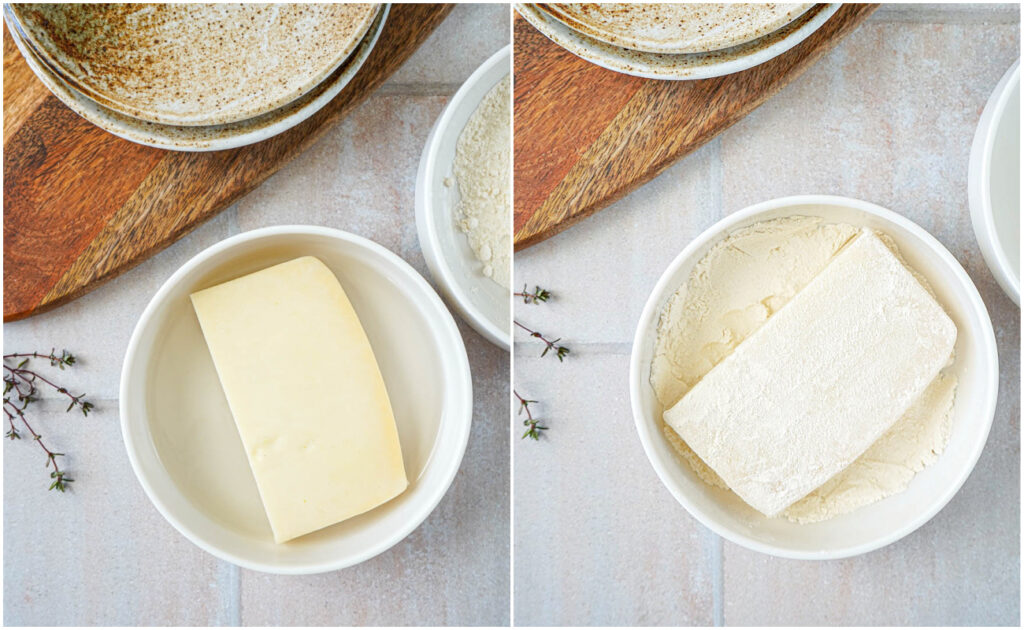A recipe for Saganaki (Greek Fried Cheese)! Thick slices of cheese are coated in flour and pan-fried in olive oil until golden.

Saganaki (Σαγανάκι) is a Greek fried cheese appetizer made in a variety of styles and variations.
Named after the two handled frying pan it is traditionally prepared in, thick cheese slices are coated lightly in flour, then pan-seared in olive oil until a crust forms on each side. This creates a wonderful contrast with the crispy, golden coating and hot, melty interior.
The cheese will cool fairly quickly after removing from heat and lose that notable texture, so the Saganaki is best served hot immediately after cooking.
I was originally inspired to make this dish after trying the Kasseri Saganaki with Pistachios and Honey at the Epcot International Food and Wine Festival in 2013.
Unfortunately, of all the treats I enjoyed at the festival, the Saganaki wasn’t my favorite. It had many positive reviews during my planning, but I must have gotten an unlucky batch. My slice was a bit sad and looked as if it spent a little too long under the warming lamps.

I wanted to give the cheese another chance at home and am so glad I tried it. The flavors were amazing and I was definitely able to see what I had been missing out on.
Cheese for Saganaki

The cheese I originally sourced for this recipe was Kasseri. Kasseri (κασέρι) is a Greek semi-hard cheese with a rubbery texture and a tart, slightly salty flavor. It is traditionally made from sheep and sometimes goat milk, though cow’s milk versions are available.
I do love the texture of Kasseri, but it is a bit more delicate and melts much quicker compared to other options. If using, cut into about 1 inch (2.5 centimeter) thick slices. If too thin, the cheese will just melt into a puddle in the skillet.
Lately, I have been making Saganaki with Kefalotyri (κεφαλοτύρι). Kefalotyri is a hard, salty cheese originating in Greece and Cyprus. It is made using sheep milk or a combination from sheep and goat and the color ranges from white to yellow.
For those in Northern Virginia, I was able to find Kefalotyri at Lotte Plaza Market in Chantilly. While in Los Angeles, I would usually get it from JONS International Marketplace in Torrance.
Other cheese options include Graviera, Kefalograviera, and Halloumi (more salty and firm).
Serving Ideas
I have included both sweet and savory options for serving the Saganaki.
Inspired by what could have been at the festival, I topped one of the cheese slices with toasted, chopped pistachios and a drizzle of honey. This continues to be a favorite.
For a more traditional savory flavor, serve the cheese immediately with a squeeze of lemon juice and optionally a few fresh thyme or parsley leaves.
In Greek-American restaurants in the United States (with possible origins in 1968 at the Parthenon restaurant in Chicago), it has become popular to set the Saganaki on fire for quite the exciting presentation.

We enjoyed the cheese this way during our latest visit to Disney World at Wine Bar George in Disney Springs. Their version used Vlahotiri as the base with Metaxa for the flambé and crostini for serving.
A Few Saganaki Tips

I have included a range for the ounces of cheese based on how the type you choose is packaged. For best results, avoid wedges (due to the inconsistent thickness) and try to find a block of cheese that can easily be trimmed into 2/3 inch (1.6 centimeter) thick slices.
I placed the water in a bowl wide enough to fit the cheese slice before coating in the flour. Another option is to simply run water from the faucet over the cheese slice briefly or brush each side with water.
Shake lightly or brush off any excess flour from the cheese before adding to the oil.
For best results, use a non-stick or well-seasoned cast iron skillet. Otherwise, it may be difficult to flip the cheese without the crust separating.
Depending on the type of cheese used, the slices may release some water while frying. If too much moisture is released, wipe out the pan and add another drizzle of olive oil before pan-frying the next batch.
Looking for more Greek recipes?
Try my:
- Spetzofai (Greek Sausage and Peppers)
- Horiatiki Salata (Greek Village Salad)
- Makaronia Me Kima (Greek Spaghetti with Meat Sauce)

This recipe was originally posted in November 2013 and updated in March 2025.
Saganaki (Greek Fried Cheese) Recipe
Adapted from The Disney Food Blog
Saganaki (Greek Fried Cheese)
Ingredients
Saganaki:
- 8-12 ounces (227-340 grams) Kefalotyri, Kasseri, Graviera, or Kefalograviera
- 1/4 cup (60 milliliters) water
- 1/4 cup (31 grams) all-purpose flour
- 1/4 cup (60 milliliters) olive oil divided
Toppings:
- Pistachios toasted and chopped
- Honey
- Lemon wedges
- Fresh thyme or parsley
Instructions
- Trim the cheese into roughly 3-4 inch (7.6-10 centimeter) square or rectangle slices about 2/3 inch (1.6 centimeter) thick. The exact sizing may differ based on the shape of cheese used. Set aside.
- Pour the water into a wide bowl.
- Place the flour on a wide bowl or plate.
- Dip each cheese slice briefly into the water, then coat with flour.
- Lightly shake or brush off any excess flour.
- Place a small, non-stick or cast iron skillet over medium heat and drizzle with a thin layer of olive oil.
- Once heated, add a slice of the floured cheese and fry until golden, 1-2 minutes.
- Carefully flip using a thin spatula, taking care to not separate the crust from the melty center, and continue to cook until golden on the other side, another 1-2 minutes.
- Carefully remove the pan-seared cheese to serving dish and repeat with remaining slices, adding more oil as needed. If too much moisture is released from the cheese between slices, wipe out the pan and start with another drizzle of oil before adding the next batch.
- Either top the cheese slices with a squeeze of lemon juice and fresh thyme/parsley leaves or top with toasted pistachios and a drizzle of honey.
- Serve the fried cheese immediately while still hot.



Chris Belote
I am just loving your site!!!!!
Tara
Thank you!